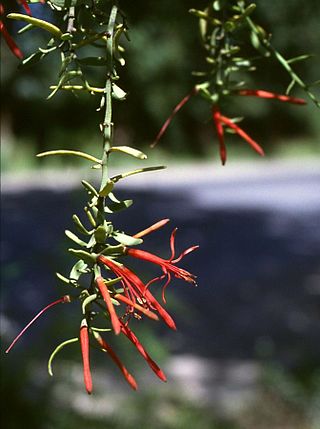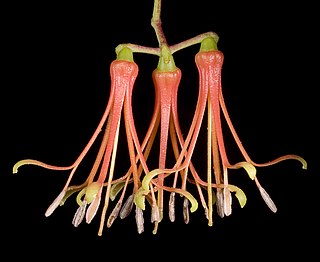
Loranthaceae, commonly known as the showy mistletoes, is a family of flowering plants. It consists of about 75 genera and 1,000 species of woody plants, many of them hemiparasites. The three terrestrial species are Nuytsia floribunda, Atkinsonia ligustrina, and Gaiadendron punctatum Loranthaceae are primarily xylem parasites, but their haustoria may sometimes tap the phloem, while Tristerix aphyllus is almost holoparasitic. For a more complete description of the Australian Loranthaceae, see Flora of Australia onlineArchived 2018-04-01 at the Wayback Machine., for the Malesian Loranthaceae see Flora of Malesia.

Amyema is a genus of semi-parasitic shrubs (mistletoes) which occur in Malesia and Australia.

Amyema quandang is a species of hemi-parasitic shrub which is widespread throughout the mainland of Australia, especially arid inland regions, sometimes referred to as the grey mistletoe.

Amyema congener, commonly known as the variable mistletoe, is a species of flowering plant, an epiphytic hemiparasitic plant of the family Loranthaceae from eastern Australia. It is found on members of the genera Allocasuarina, Acacia and some exotic species.

Dendrophthoe glabrescens, commonly known as smooth mistletoe or orange mistletoe, is a hemiparasitic plant of the mistletoe family Loranthaceae, found in eastern and northern Australia. It flowers from October to January. The flowers are tubular, with a green base, but where the tube splits open, it displays orange and bright red.

Amyema preissii, commonly known as wireleaf mistletoe, is a species of mistletoe, an epiphytic, hemiparasitic plant of the family Loranthaceae. It is native to Australia where it has been recorded from all mainland states. The flowers are red and up to 26 mm long. The fruits are white or pink, globose and 8–10 mm in diameter. Its habitat is sclerophyll forest and woodland where it is often found on wattles. On Victoria's Bellarine Peninsula its hosts include coast wirilda, golden wattle and drooping sheoak. Its sticky seeds are eaten and dispersed by mistletoebirds.

Amyema benthamii, commonly known as the twin-leaved mistletoe or Bentham's mistletoe, is a species of flowering plant, an epiphytic hemiparasitic plant of the family Loranthaceae native to Western Australia and the Northern Territory of Australia in semi-arid woodland. This species is named in honour of the English botanist George Bentham who between 1863 and 1878 published Flora Australiensis, the first flora of Australia.

Lysiana exocarpi, commonly known as harlequin mistletoe, is a species of hemiparasitic shrub, endemic to Australia. It is in the Gondwanan family Loranthaceae and is probably the most derived genus of that family with 12 pairs of chromosomes. The Loranthaceae is the most diverse family in the mistletoe group with over 900 species worldwide and including the best known species in Australia. Mistletoes are notable for their relationships with other species. In an early reference to the group in Australia Allan Cunningham explorer and first Director of the Royal Botanic Gardens, Sydney, wrote in 1817: "The Bastard Box is frequently much encumbered with the twining adhering Loranthus aurantiacus which 'Scorning the soil, aloft she springs, Shakes her red plumes and claps her golden wings'."

Amyema bifurcata is an epiphytic, flowering, hemiparasitic plant of the family Loranthaceae native to Australia and found in Western Australia, the Northern Territory, Queensland and New South Wales.

Amyema maidenii is a species of flowering plant within the genus Amyema, an epiphytic hemiparasitic plant of the family Loranthaceae native to Australia and found Australia-wide in the inland.

Amyema mackayensis, the mangrove mistletoe, is a species of flowering plant within the genus Amyema, an epiphytic hemiparasitic plant of the family Loranthaceae native to Australia, and found along its northern and eastern coasts in New South Wales, Queensland, the Northern Territory and Western Australia, and also in New Guinea.

Amyema fitzgeraldii, the pincushion mistletoe, is a species of flowering plant within the genus Amyema, an epiphytic hemiparasitic plant of the family Loranthaceae endemic to Australia, and found in the Northern Territory, South Australia and Western Australia.

Amyema sanguinea is an aerial hemiparasitic shrub within the genus Amyema, in the family Loranthaceae and native to Australia, where it is found in New South Wales, Queensland, the Northern Territory, South Australia and Western Australia.

Amyema gibberula is an aerial hemiparasitic plant of the family Loranthaceae native to Australia and found in Western Australia, the Northern Territory, and South Australia.

Amyema melaleucae, also known as the tea-tree mistletoe, is a species of flowering plant within the genus Amyema, an epiphytic hemiparasitic plant of the family Loranthaceae native to Australia and found in Western Australia and South Australia on the coast, from north of Perth almost to the Victorian border.

Muellerina bidwillii, common name Cypress-pine mistletoe, is a hemiparasitic aerial shrub in the family Loranthaceae. The species is endemic to New South Wales and Queensland.

Muellerina myrtifolia, common name myrtle-leaved mistletoe, is a hemiparasitic aerial shrub in the family Loranthaceae. The species is endemic to New South Wales and Queensland.

Muellerina celastroides, common names Banksia mistletoe and coast mistletoe, is a hemiparasitic aerial shrub in the family Loranthaceae. The species is endemic to New South Wales, Victoria and Queensland.

Amyema plicatula is a species of hemi-parasitic shrub found in the Bismarck Archipelago, New Guinea, New South Wales and Queensland.

Amyema miraculosa, also known as the fleshy mistletoe and the round-leaf mistletoe, is an Australian native mistletoe found in all states except Tasmania. It is a woody, hemiparasitic plant, in the Loranthaceae family. Being hemiparasitic, it draws water and minerals from its host, however it photosynthesises to manufacture its own supply of carbohydrates.





















